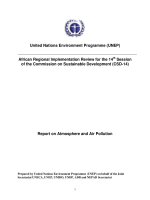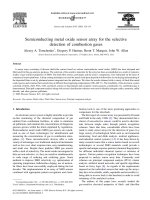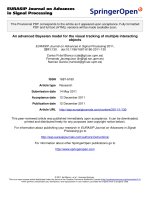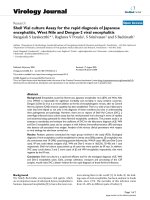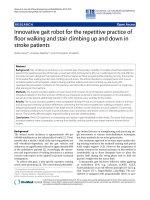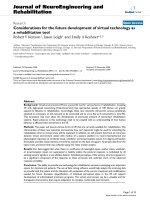NON INTEGRATED DEFECT RELATIONS FOR THE GAUSS MAPS OF COMPLETE MINIMAL SURFACES WITH FINITE TOTAL CURVATURE
Bạn đang xem bản rút gọn của tài liệu. Xem và tải ngay bản đầy đủ của tài liệu tại đây (343.6 KB, 13 trang )
NON-INTEGRATED DEFECT RELATIONS FOR THE
GAUSS MAPS OF COMPLETE MINIMAL SURFACES
WITH FINITE TOTAL CURVATURE
PHAM HOANG HA AND NGUYEN VAN TRAO
Abstract. In this article, we give the non-integrated defect relations in the sense of Fujimoto for the Gauss maps of complete
minimal surfaces with finite total curvature in R3 , R4 . These are
some strict improvements of previous results for the ramifications
and modified defect relations of the Gauss maps of complete minimal surfaces with finite total curvature.
1. Introduction
Let M be a complete non-flat minimal surface in R3 and let g be the
Gauss map of M. The initial result which says that g cannot omit a
set of positive logarithmic capacity was obtained by Osserman [17] in
1963. In 1981, Xavier [20] proved that g can at most omit 6 points in
S 2 . In 1988, Earp and Rosenberg [4] proved that, if additionally M is
of finite topology and infinite total curvature, then g takes every value
infinitely many times with 6 exceptions. In the same year, Fujimoto [7]
proved that g can omit at most 4 points, and the bound is sharp. In
1990, Mo and Osserman [16] generalized Fujimoto’s method to obtain
the following result which puts the connection between total curvature
and Gauss map in final form: The Gauss map of a complete minimal
surface in R3 assumes every value infinitely often with at most four
exceptions, unless the surface have finite total curvature. After that
many results related to this topic were given (see [5], [19], [15], [12] and
[3] for examples).
2010 Mathematics Subject Classification. Primary 53A10; Secondary 53C42,
30D35, 32A22.
Key words and phrases. Minimal surface, Gauss map, Defect relation.
1
2
PHAM HOANG HA AND NGUYEN VAN TRAO
On the other hand, Fujimoto [8], [9] introduced the modified defects
for the Gauss maps of complete minimal surfaces. He then gave the improvements of the above-mentioned results. Recently, the first named
author and Trang [13] also proved the modified defect relations of the
Gauss maps of complete minimal surfaces in R3 and R4 on annular
ends which are similar to the ones obtained by Fujimoto in [8]. In this
article, we intend to study the non-integrated defect relations for the
Gauss maps of complete minimal surfaces with finite total curvature.
These are the strict improvements of all previous results of Fujimoto on
the modified defect relations for the Gauss maps of complete minimal
surfaces in R3 and R4 with finite total curvature. Thus, they are the
improvements of previous results on ramifications for the Gauss maps
of complete minimal surfaces with finite total curvature in R3 and R4 .
2. Statements of the main results
We now recall the knowledges of modified defects in [8].
Let M be an open Riemann surface and f a nonconstant holomorphic
map of M into P1 (C). Assume that f has reduced representation f =
(f0 : f1 ). Set ||f || = (|f0 |2 +|f1 |2 )1/2 and, for each α = (a0 : a1 ) ∈ P1 (C)
with |a0 |2 + |a1 |2 = 1, we define Fα := a1 f0 − a0 f1 .
Definition 1. We define the non-integrated defect (or the S−defect)
of α for f by
δfS (α) := 1 − inf{η ≥ 0; η satisfies condition (∗)S }.
Here, condition (∗)S means that there exists a [−∞, ∞)−valued continuous subhamornic function u (≡ −∞) on M satisfying the following
conditions:
(C1) eu ≤ ||f ||η ,
(C2) for each ξ ∈ f −1 (α), there exists the limit
lim(u(z) − log |z − ξ|) ∈ [−∞, ∞),
z→ξ
where z is holomorphic local coordinate around ξ.
NON-INTEGRATED DEFECT RELATIONS
3
Definition 2. We define the H−defect of α for f by
δfH (α) := 1 − inf{η ≥ 0; η satisfies condition (∗)H }.
Here, condition (∗)H means that there exists a [−∞, ∞)−valued continuous subhamornic function u on M which is hamornic on M −f −1 (α)
and satisfies the conditions (C1) and (C2).
Definition 3. We define the O−defect of α for f by
δfO (α) := 1 − inf{
1
; Fα has no zero of order less than m}.
m
Remark 1. We always have 0 ≤ δfO (α) ≤ δfH (α) ≤ δfS (α) ≤ 1.
Moreover, Fujimoto [6, page 672] also gave the reasons why he calls
non-intergrated defect by showing a relation between the nonintergrated defect and the defect (as in Nevanlinna theory) of a nonconstant holomorphic map of ∆R into P1 (C).
We now recall the following.
δfS (α)the
Definition 4. f is called to be ramified over a point α ∈ P1 (C) with
multiplicity at least m if all the zeros of the function Fα have orders at
least m. If the image of f omits α, we will say that f is ramified over
α with multiplicity ∞.
Remark 2. If f ramified over a point α ∈ P1 (C) with multiplicity at
1
least m, then δfS (α) ≥ δfH (α) ≥ δfO (α) ≥ 1 − . In particular, if
m
f −1 (α) = ∅, then δfO (α) = 1.
In this article, we would like to show the S−defect relations for the
Gauss maps of minimal surfaces with finite total curvature in R3 which
are similar to the H−defect relations for the Gauss maps of minimal
surfaces obtained by Fujimoto in [8]. Namely, we prove the following
for the first purpose.
Theorem 1. Let x = (x1 , x2 , x3 ) : M → R3 be a non-flat complete
minimal surface with finite total curvature and g : M → P1 (C) the
4
PHAM HOANG HA AND NGUYEN VAN TRAO
Gauss map. For arbitrary q distinct points α1 , ..., αq in P1 (C), then
q
δgS (αj ) ≤ 4.
j=1
Moreover, we also would like to consider a complete minimal surfaces
M immersed in R4 , this special case has been investigated by various
authors (see, for example [2], [8], [14], [3] and [13]). Then, the Gauss
map of M may be identified with a pair of meromorphic functions
g = (g 1 , g 2 ) (we also refer the readers to [11] for more details). We
shall prove the following theorem for the last purpose of this article.
Theorem 2. Suppose that M is a complete non-flat minimal surface
in R4 with finite total curvature and g = (g 1 , g 2 ) is the Gauss map of
M. Let α11 , ..., α1q1 , α21 , ..., α2q2 be q1 + q2 (q1 , q2 > 2) distinct points in
P1 (C).
(i) In the case g l ≡ constant (l = 1, 2), then
q1
q2
S
1j
S
2j
j=1 δg 1 (α ) ≤ 2, or
j=1 δg 2 (α ) ≤ 2, or
1
q1
S
1j
j=1 δg 1 (α )
−2
+
1
q2
S
2j
j=1 δg 2 (α )
2
−2
≥ 1.
(ii) In the case where one of g 1 and g is constant, say g 2 ≡ constant,
we have the following
q1
δgS1 (α1j ) ≤ 3.
j=1
Remark 3. For the case of the Gauss maps of minimal surfaces with
finite total curvature, we can show that:
i) Theorem 1 improved strictly Theorem 1.3 in [6](by reducing the
number 6 to the number 4) and Theorem I in [8](by changing the H−
defect relations to the S− defect relations).
ii) Theorem 2 improved strictly Theorem 6.3 in [6] and Theorem III in
[8] (by changing the H− defect relations to the S− defect relations).
3. Preliminaries and auxiliary lemmas
In this section, we recall some auxiliary lemmas in [8], [9].
Let M be an open Riemann surface and ds2 a pseudo-metric on M ,
NON-INTEGRATED DEFECT RELATIONS
5
namely, a metric on M with isolated singularities which is locally written as ds2 = λ2 |dz|2 in terms of a nonnegative real-value function λ
with mild singularities and a holomorphic local coordinate z. We define
the divisor of ds2 by νds := νλ for each local expression ds2 = λ2 |dz|2 ,
which is globally well-defined on M . We say that ds2 is a continuous
pseudo-metric if νds ≥ 0 everywhere.
Definition 5. (see [9]) We define the Ricci form of ds2 by
Ricds2 := −ddc log λ2
for each local expression ds2 = λ2 |dz|2 .
In some cases, a (1, 1)−form Ω on M is regarded as a current on M
by defining Ω(ϕ) := M ϕΩ for each ϕ ∈ D, where D denotes the space
of all C ∞ differentiable functions on M with compact supports.
Definition 6. (see [9]) We say that a continuous pseudo-metric ds2
has strictly negative curvature on M if there is a positive constant C
such that
−Ricds2 ≥ C · Ωds2 ,
where Ωds2 denotes the area form for ds2 , namely,
√
Ωds2 := λ2 ( −1/2)dz ∧ d¯
z
for each local expression ds2 = λ2 |dz|2 .
As is well-known, if the universal covering surface of M is biholomorphic with the unit disc in C, then M has the complete conformal
metric with constant curvature −1 which is called the Poincar´e metric
2
of M and denoted by dσM
.
Let f be a nonconstant holomorphic map of open minimal surface
M into P1 (C). Take a reduced representation f = (f0 : f1 ) on M and
define
||f || := (|f0 |2 + |f1 |2 )1/2 , W (f0 , f1 ) := f0 f1 − f1 f0 .
Let αj = (aj0 : aj1 )(1 ≤ j ≤ q) be q distinct points in P1 (C),
with |aj0 |2 + |aj1 |2 = 1, we define Fj := aj1 f0 − aj0 f1 .
We now consider [−∞, ∞)−valued continuous subhamornic functions
6
PHAM HOANG HA AND NGUYEN VAN TRAO
uj (≡ −∞) on M and nonnegative numbers ηj (1 ≤ j ≤ q) satisfying
the conditions:
(D0) γ := q − 2 − qj=1 ηj > 0,
(D1) euj ≤ ||f ||ηj for j = 1, ..., q,
(D2) for each ξ ∈ f −1 (αj ) (1 ≤ j ≤ q), there exists the limit
lim(uj (z) − log |z − ξ|) ∈ [−∞, ∞).
z→ξ
Lemma 3. (see [8]) For each > 0 there exist positive constants C
and µ depending only on α1 , · · · , αq and on respectively such that
∆ log
C||f ||2q−4 |W (f0 , f1 )|2
≥ q
.
Πj=1 |Fj |2 log2 (µ||f ||2 /|Fj |2 )
||f ||
q
Πj=1 log(µ||f ||2 /|Fj |2 )
Lemma 4. (see [8]) There exist positive constants C and µ(> 1) depending only on αj and ηj (1 ≤ j ≤ q) which satisfy that if we set
q
C||f ||γ e j=1 uj |W (f0 , f1 )|
v := q
Πj=1 |Fj | log(µ||f ||2 /|Fj |2 )
on M − A and v := 0 on M ∩ A (where A := {z ∈ M ; Πqj=1 Fj = 0}),
then v is continuous on M and satisfies the condition ∆ log v ≥ v 2 in
the sense of distribution.
Set Ωf = ddc log ||f ||2 . We have the following.
Lemma 5. For each > 0 such that γ − > 0, there exists a real
number µ(> 1) depending only on αj and ηj (1 ≤ j ≤ q) which satisfy
that if we set
q
||f ||γ e j=1 uj |W (f0 , f1 )|
λ := q
Πj=1 |Fj | log(µ||f ||2 /|Fj |2 )
on M − A, where A := {z ∈ M ; Πqj=1 Fj = 0}, then
ddc log λ2 ≥ (γ − )Ωf .
Proof. We have
q
c
2
c
dd log λ = (γ − )Ωf + dd log
≥ (γ − )Ωf + ddc log
||f || e j=1 uj
Πqj=1 log(µ||f ||2 /|Fj |2 )
Πqj=1
||f ||
.
log(µ||f ||2 /|Fj |2 )
NON-INTEGRATED DEFECT RELATIONS
7
Using Lemma 4, we get
ddc log λ2 ≥ (γ − )Ωf .
4. The proof of the Theorem 1
Proof. Let x = (x1 , x2 , x3 ) : M → R3 be a non-flat complete minimal
surface and g : M → P1 (C) the Gauss map. Set φi := ∂xi /∂z (i =
√
1, 2, 3) and r := φ1 − −1φ2 . Then, the Gauss map g : M → P1 (C) is
given by
φ3
√
,
g=
φ1 − −1φ2
and the metric on M induced from R3 is given by
ds2 = |r|2 (1 + |g|2 )2 |dz|2 (see [11]).
Take a reduced representation g = (g0 : g1 ) on M and set ||g|| = (|g0 |2 +
|g1 |2 )1/2 . Then we can rewrite ds2 = |h|2 ||g||4 |dz|2 , where h := r/g02 .
Now, for given q distinct points α1 , ..., αq in P1 (C) we assume that
q
δgS (αj ) > 4.
(4.1)
j=1
From (4.1), by Definition 1, there exist constants ηj ≥ 0(1 ≤ j ≤ q)
such that
q
γ =q−2−
ηj > 2
j=1
and continuous subhamornic functions uj (1 ≤ j ≤ q) on M satisfying
conditions (D1) and (D2).
We set a new metric
q
2
dτ :=
|h|||g||γ e j=1 uj |W (g0 , g1 )|
Πqj=1 |Gj | log(µ||g||2 /|Gj |2 )
2
|dz|2 = λ2 |dz|2 ,
where Gj = aj1 g0 − aj0 g1 .
It is easily to see that dτ 2 is well-defined on M. By Lemma 4, we see
that dτ 2 is continuous and has strictly negative curvature on M.
Now, because M has the continuous pseudo-metric dτ 2 which has
8
PHAM HOANG HA AND NGUYEN VAN TRAO
strictly negative curvature on M and there is no continuous pseudometric with strictly negative curvature on a Riemann surface whose
universal covering surface is biholomorphic to C, we give that the universal covering surface of M is biholomorphic to the unit disc. By the
generalized Schwarz’s lemma [1], there exists a positive constant C0
such that
2
,
dτ 2 ≤ C0 dσM
2
where dσM
denotes the Poincar´e metric on M .
Now, for each al , we take a neighborhood Ul of al which is biholomorphic to ∆∗ = {z; 0 < |z| < 1} , where z(al ) = 0. The Poincar´e metric
on domain ∆∗ is given by
2
dσ∆
∗ =
4|dz|2
.
|z|2 log2 |z|2
By using the distance decreasing property of the Poincar´e metric, we
have
|dz|2
2
dτ ≤ Cl 2 2 2
|z| log |z|
with some Cl > 0 . This implies that, for a neighborhood Ul∗ of al
which is relatively compact in Ul , we have
Ωdτ 2 < +∞.
Ul∗
Since M is compact, we have
Ωdτ 2 ≤
M
Ωdτ 2 +
M −∪l Ul∗
Ωdτ 2 < +∞.
(4.2)
Ul∗
l
On the other hand, we now take a nowhere zero holomorphic form
ω on M.
Choose the positive real number > 0 such that γ − > 2. Then, since
ddc log λ2 ≥ (γ − )Ωg by Lemma 5, we can find a subharmonic function
v such that
λ2 |dz|2 = ev ||g||2(γ− ) |ω|2
2
= ev+(γ− −2) log ||g|| ||g||4 |ω|2
= ew ds2 .
NON-INTEGRATED DEFECT RELATIONS
9
So dτ 2 = ew ds2 , where w is a subharmonic function. Here, we can
apply the result of Yau in [21] to see
ew Ωds2 = +∞,
M
because of the minimality of M with respect to the metric ds2 . This
contradicts the assertion (4.2). The proof of Theorem 1 is completed.
5. The proof of Theorem 2
Proof. Let x = (x1 , x2 , x3 , x4 ) : M → R4 be a non-flat complete minimal surface in R4 . As is well-known, the set of all oriented 2-planes in
R4 is canonically identified with the quadric
Q2 (C) := {(w1 : ... : w4 )|w12 + ... + w42 = 0}
in P3 (C). By definition, the Gauss map g : M → Q2 (C) is the map
which maps each point p of M to the point of Q2 (C) corresponding to
the oriented tangent plane of M at p. The quadric Q2 (C) is biholomorphic to P1 (C) × P1 (C). By suitable identifications we may regard g as
a pair of meromorphic functions g = (g 1 , g 2 ) on M.
Set φi := ∂xi /dz for i = 1, ..., 4. Then, g 1 and g 2 are given by
√
√
φ3 + −1φ4 2 −φ3 + −1φ4
1
√
√
g =
, g =
φ1 − −1φ2
φ1 − −1φ2
and the metric on M induced from R4 is given by
ds2 = |φ|2 (1 + |g 1 |2 )(1 + |g 2 |2 )|dz|2 , (see [11]),
√
where φ := φ1 − −1φ2 .
Take reduced representations g l = (g0l : g1l ) on M and set ||g l || =
(|g0l |2 + |g1l |2 )1/2 for l = 1, 2. Then we can rewrite
ds2 = |h|2 ||g 1 ||2 ||g 2 ||2 |dz|2 (4.1),
where h := φ/(g01 g02 ).
We firstly study the case g l ≡ constant, for l = 1, 2. Assume that
10
PHAM HOANG HA AND NGUYEN VAN TRAO
q1
S
1j
j=1 δg 1 (α )
> 2,
q2
S
2j
j=1 δg 2 (α )
1
q1
S
1j
j=1 δg 1 (α )
> 2, and
1
+
−2
q2
S
2j
j=1 δg 2 (α )
−2
< 1.
(5.3)
From (5.3), by Definition 1, there exist constants ηlj ≥ 0(1 ≤ j ≤ q; l =
1, 2) such that
q
γl = ql − 2 −
ηlj > 0,
j=1
1
1
+
< 1,
γ1 γ2
and continuous subhamornic functions ulj (1 ≤ j ≤ q; l = 1, 2) on M
satisfying conditions (D1) and (D2).
Choose δ0 (> 0) such that γl − ql δ0 > 0 for all l = 1, 2, and
1
1
+
= 1.
γ1 − q1 δ0 γ2 − q2 δ0
If we set
pl := 1/(γl − ql δ0 ), (l = 1, 2),
we thus have
p1 + p2 = 1.
Taking the positive real numbers
l
> 0(l = 1, 2) such that
pl (γl − l ) > 1, (l = 1, 2).
(5.4)
We now set a new metric
q
dτ22
:= Πl=1,2
|h|||g l ||γl e j=1 uj |W (g0l , g1l )|
Πqj=1 |Glj | log(µ||g l ||2 /|Glj |2 )
2pl
|dz|2 = Πl=1,2 λ2l |dz|2 ,
lj l
l
where Glj := alj
0 g1 − a1 g0 (l = 1, 2).
It is also easy to see that dτ22 is well-defined on M . We now use Lemma
4 to see that dτ22 is continuous and has strictly negative curvature.
Now repeating the proof for the case (4.2) in the proof of Theorem
1,we also have
M
Ωdτ22 ≤
M −∪l Ul∗
Ωdτ22 +
l
Ul∗
Ωdτ22 < +∞.
(5.5)
NON-INTEGRATED DEFECT RELATIONS
11
On the other hand, we now take a nowhere zero holomorphic form
ω on M. Since ddc log λ2l ≥ pl (γl − l )Ωgl (l = 1, 2) by Lemma 5, we can
find two subharmonic functions v1 , v2 such that
Πl=1,2 λ2l |dz|2 = (Πl=1,2 evl ||g l ||2pl (γl − l ) )|ω|2
l 2
= (Πl=1,2 evl +(pl (γl − l )−1) log ||g || ||g l ||2 )|ω|2
= ew ds2 .
So dτ22 = ew ds2 , where w is a subharmonic function by (5.4). Here, we
apply again the result of Yau in [21] to get
ew Ωds2 = +∞,
M
because of the minimality of M with respect to the metric ds2 . This
contradicts the assertion (5.5). The proof of Theorem 2 is completed.
We finally consider the case where g 2 ≡ constant and g 1 ≡ constant.
1
Suppose that qj=1
δgS1 (α1j ) > 3. By definition, there exist constants
η1j ≥ 0(1 ≤ j ≤ q) such that
q1
γ3 = q1 − 2 −
η1j > 1
j=1
and continuous subhamornic functions u1j (1 ≤ j ≤ q1 ) on M satisfying
conditions (D1) and (D2). Choose the positive real number 3 > 0 such
that γ3 − 3 > 1.
Set
q1
dτ32
:=
|h|||g 1 ||γ3 e j=1 u1j |W (g01 , g11 )|
1
Πqj=1
|G1j | log(µ||g 1 ||2 /|G1j |2 )
2
|dz|2 = λ23 |dz|2 .
By exactly the same arguments as in the proof of Theorem 1, we get
Theorem 2(ii).
Acknowledgements. This work was completed during a stay of
the first named author at the Vietnam Institute for Advanced Study
in Mathematics (VIASM). He would like to thank this institution for
financial support and hospitality. We are also grateful to Professor Do
Duc Thai for many stimulating discussions concerning this material.
12
PHAM HOANG HA AND NGUYEN VAN TRAO
References
[1] L. V. Ahlfors, An extension of Schwarz’s lemma, Trans. Amer. Math. Soc., 43
(1938), 359-364.
[2] C. C. Chen, On the image of the generalized Gauss map of a complete minimal
surface in R4 , Pacific J. Math. 102 (1982), 9-14.
[3] G. Dethloff and P. H. Ha, Ramification of the Gauss map of complete minimal
surfaces in R3 and R4 on annular ends, Ann. Fac. Sci. Toulouse Math., 23
(2014), no. 4, 829-846.
[4] R. S. Earp and M. Rosenberg, On values of the Gauss maps of complete minimal surfaces in R3 , Comment. Math. Helv. 63 (1988), 579-586.
[5] Y. Fang, On the Gauss map of complete minimal surfaces with finite total
curvature, Indiana Univ. Math. J. 42 (1993),1389-1411.
[6] H. Fujimoto, Value distribution of the Gauss maps of complete minimal surfaces in Rm , J. Math. Soc. Japan, 35 (1983),no. 4, 663-681.
[7] H. Fujimoto, On the number of exceptional values of the Gauss maps of minimal surfaces, J. Math. Soc. Japan, 40 (1988), 235-247.
[8] H. Fujimoto, Modified defect relations for the Gauss map of minimal surfaces,
J. Differential Geom., 29 (1989), 245-262.
[9] H. Fujimoto, Modified defect relations for the Gauss map of minimal surfaces
III, Nagoya Math. J., 124 (1991), 13-40.
[10] H. Fujimoto, Unicity theorems for the Gauss maps of complete minimal surfaces II, Kodai Math. J, 16 (1993), 335-354.
[11] H. Fujimoto, Value Distribution Theory of the Gauss map of Minimal Surfaces
in Rm , Aspect of Math., Vol. E21, Vieweg, Wiesbaden (1993).
[12] P. H. Ha, An estimate for the Gaussian curvature of minimal surfaces in Rm
whose Gauss map is ramified over a set of hyperplanes, Differential Geom.
Appl. 32 (2014), 130-138.
[13] P. H. Ha and N. H. Trang, Modified defect relations of the Gauss map of
complete minimal surfaces on annular ends, arXiv:1408.3075.
[14] Y. Kawakami, The Gauss map of pseudo-algebraic minimal surfaces in R4 ,
Math. Nachr. 282 (2009), 211-218.
[15] Y. Kawakami, R. Kobayashi, and R. Miyaoka, The Gauss map of pseudoalgebraic minimal surfaces, Forum Math., 20 (2008), 1055-1069.
[16] X. Mo and R. Osserman, On the Gauss map and total curvature of complete
minimal surfaces and an extension of Fujimoto’s theorem, J. Differential Geom.
31 (1990), 343-355.
[17] R. Osserman, On complete minimal surfaces, Arch. Rational Mech. Anal., 13
(1963), 392-404.
NON-INTEGRATED DEFECT RELATIONS
13
[18] R. Osserman, Global properties of minimal surfaces in E 3 and E n , Ann. of
Math., 80 (1964), 340-364.
[19] M. Ru, Gauss map of minimal surfaces with ramification, Trans. Amer. Math.
Soc., 339 (1993), 751-764.
[20] F. Xavier, The Gauss map of a complete non-flat minimal surface cannot omit
7 points of the sphere, Ann. of Math., 113 (1981), 211-214; Erratum: Ann. of
Math., 115 (1982), 667.
[21] S. T. Yau, Some function-theoretic properties of complete Riemannian manifolds and their applications to geometry, Indiana Univ. Math. J., 25 (1976),
659-670.
Department of Mathematics, Hanoi National University of Education, 136 XuanThuy str., Hanoi, Vietnam
E-mail address:
,


